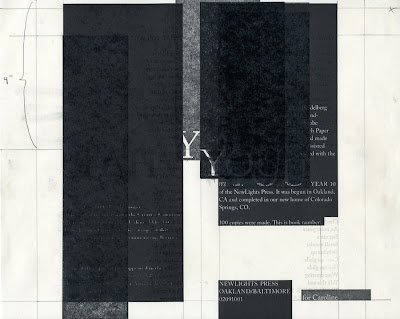skip to main |
skip to sidebar


The images above show the cover of What You Will where it currently stands, 62 runs deep, with 26 on the left side now, and 36 on the right. Every plate used in the printing of the book is printed on the covers in white, in its exact location on the page, one on top of another. The books will be bound with a double-signature pamphlet stitch, so there are two cover sheets for every book, printed exactly the same on the front and back. So when the covers are folded and wrapped around and into the pages, the rectos of both sides of the cover will have all of the plates from the recto pages of the book, and the versos of the cover will have all of the verso plates of the pages. The layered structure of the entire book will be visible at once, both collapsing and exploding the pages.Printing right now is very routine: just switching plates, making slight adjustments to the position, and printing long runs (100 books x 2 covers per book x 2 sides per cover = 400 impressions per plate). Yesterday I was reminded of an incident in one my painting classes when I was in art school in Baltimore, an “incident” that at the time was small (a normal critique of work done in class) but looking back from here, that professor, was, in a way, predicting the future….The first semester of my sophomore year (Fall of 1999, the semester before I learned to print and started the NewLights Press) I was in a painting class that was based loosely around traditional techniques of figure painting in oils (glazing, etc.), but also featured a large amount of independent work. I was in the class mostly because I wanted to work with that professor, who was great. One day we were doing an in-class figure painting from a model. I was working on small, square canvas, and had set up a painting where most of the model was cropped off of the canvas and the majority of the composition was the white wall behind him. Because what I was interested in was painting that wall.And so I tried to paint the wall (on my canvas), but I really wasn’t trying to paint an image an image of the wall (I thought I was), I was just putting white paint onto the surface of the canvas and enjoying that. The professor stopped me and explained that I wasn’t really painting, in the sense of trying to make a picture, but that I was just “marking time,” making a series of essentially arbitrary brushstrokes on a surface. The only thing being articulated by those strokes was the time it took to make them.This was before I learned to make books. I thought of myself, more or less, as a painter. I was trying (not really trying) to be a “good” one. I had no idea what that meant. I was 19. I had not yet been pointed to the work of Robert Ryman, though it probably happened soon after this “event,” perhaps because of it: Robert Ryman, Ledger, Enamelac paint on fiberglass, aluminum and wood, 1982.
Robert Ryman, Ledger, Enamelac paint on fiberglass, aluminum and wood, 1982.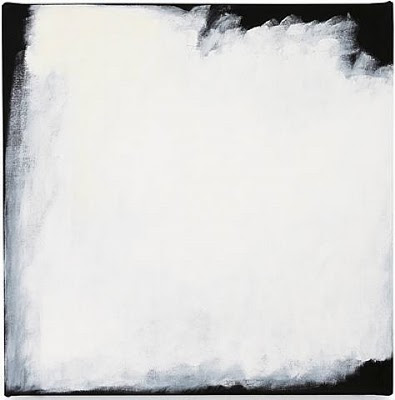 Robert Ryman, Series #33 (White), Oil on canvas, 2004.That professor was pointing out that my engagement with that painting was an engagement with the raw or mundane or technological aspects of the process: making marks on a surface. That was a valid critique from his point-of-view, the point-of-view of the assignment, because we were supposed to be doing a figure painting from life. But sometimes critiques like that open up other doors. And I think that is one of the main things that made this professor good—he didn’t just tell me to stop and get back to the figure, but talked to me about what I was doing, helping me to see something in my approach that I was blind to. [Thank you, Karl.]So fast forward to yesterday. I was printing, white block after white block. And at some point I stopped, and thought: Am I just marking time?And the answer, at least for the moment, seems to be yes and no—yes, marking time, but no, not just marking time. Marking time because the time of the process of printing the book was being articulated on a single surface and distributed across the edition. Marking time because the temporal structure of the book would be legible at once. Not marking time because the surface of the page, and its 2D composition were also being articulated. Not just marking time because that time will be re-inscribed into the here-and-now of the reading of the book, of the reader’s understanding of the book as an object, as a made thing-in-the world.
Robert Ryman, Series #33 (White), Oil on canvas, 2004.That professor was pointing out that my engagement with that painting was an engagement with the raw or mundane or technological aspects of the process: making marks on a surface. That was a valid critique from his point-of-view, the point-of-view of the assignment, because we were supposed to be doing a figure painting from life. But sometimes critiques like that open up other doors. And I think that is one of the main things that made this professor good—he didn’t just tell me to stop and get back to the figure, but talked to me about what I was doing, helping me to see something in my approach that I was blind to. [Thank you, Karl.]So fast forward to yesterday. I was printing, white block after white block. And at some point I stopped, and thought: Am I just marking time?And the answer, at least for the moment, seems to be yes and no—yes, marking time, but no, not just marking time. Marking time because the time of the process of printing the book was being articulated on a single surface and distributed across the edition. Marking time because the temporal structure of the book would be legible at once. Not marking time because the surface of the page, and its 2D composition were also being articulated. Not just marking time because that time will be re-inscribed into the here-and-now of the reading of the book, of the reader’s understanding of the book as an object, as a made thing-in-the world.
I decided today that I will hereafter, at least in conversation, refer to “printing” as “partying.” That way I can say things like “I spent this entire summer partying,” or “I get up at 6 AM everyday so that I can start partying as soon as possible,” or “All this partying is just killing me.” Man, I can’t wait to PARTY ALL WEEKEND LONG.
This lovely tired morning and looking over the current draft for the second iteration of The New Manifesto of the NewLights Press. Here’s an excerpt:If we are to engage with the labor of making books we must not do so only in an effort to preserve them and the traditional crafts that go into making them. We must not lock them in the display cases, the glass coffins, of the museum. The book has a long history, but it is not, never has been, must never be, an object frozen in time. The book has a long history, but it is our job, as producers and readers, to make sure that it continues to have a living present. Everything that we cherish about books, about making them, reading them, owning them, collecting them, living with and through them, will be preserved if they continue to be culturally relevant. We must keep them out of the museums, out of the archives. They must live in our libraries, in our streets, in our stores, on our bookshelves, and in our hands.Books are not art in the traditional sense. Books do not require viewers. A book viewed is a book dead. Books need readers, and thus they must circulate outside of the venues of art alone. A book read is a book alive, breathing, beating, shining and reverberating through its readers.
The other day a friend of mine offered me space for a free ad in a publication that she was putting together (it was free because she ended up with 2 extra pages that needed to be filled quickly). I said yes. Then I was stuck with the odd task of making an advertisement for NewLights. I have never actually made anything that was strictly and discreetly an ad, at least for the press. So a new challenge. Strange to try to embody the whole thing in a single image/text composition. It is, after all, about movement. But the image below shows what I ended up with:
 A while ago I wrote a post describing the severe physical consequences of not storing one’s photopolymer plates properly. I never really tried to print those curled plates—I attempted to attach one to the base to see if it would flatten out, and it didn’t, so those never got used. But I did, at another time, for another project, manage to print from some plates that were severely warped.The pictures shown in this post are from January of 2011. [I had forgotten about them until recently.] Before I left the Bay Area in August of 2010, I had made the plates necessary to print the letterpress portion of KC Trommer’s and Brenda Iijima’s broadsides. Those plates were stuck in an envelope and shipped to Colorado, and then they sat at the Press until I made time to print them in January. Which means they had been sitting, with minimal protection from the environment, for roughly 5 months. I think that the envelope that they were in did keep most light off of them, and provided restraint against severe curling, but they were far from perfect. Fortunately, for these projects, less-than-perfect plates were okay. (All of the printed “negative” space on these would eventually be peeled away, so print quality did not matter.) And their less-than-perfectness provided some interesting results.
A while ago I wrote a post describing the severe physical consequences of not storing one’s photopolymer plates properly. I never really tried to print those curled plates—I attempted to attach one to the base to see if it would flatten out, and it didn’t, so those never got used. But I did, at another time, for another project, manage to print from some plates that were severely warped.The pictures shown in this post are from January of 2011. [I had forgotten about them until recently.] Before I left the Bay Area in August of 2010, I had made the plates necessary to print the letterpress portion of KC Trommer’s and Brenda Iijima’s broadsides. Those plates were stuck in an envelope and shipped to Colorado, and then they sat at the Press until I made time to print them in January. Which means they had been sitting, with minimal protection from the environment, for roughly 5 months. I think that the envelope that they were in did keep most light off of them, and provided restraint against severe curling, but they were far from perfect. Fortunately, for these projects, less-than-perfect plates were okay. (All of the printed “negative” space on these would eventually be peeled away, so print quality did not matter.) And their less-than-perfectness provided some interesting results.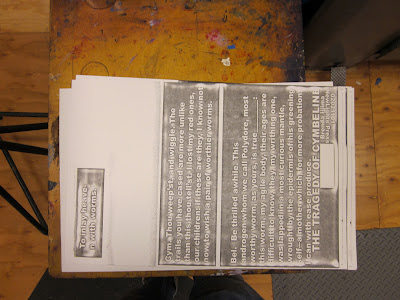
 Two things made these plates particularly prone to warping—the large amount of solid areas of type-high polymer, and the very dry climate here in Colorado. One thing that I was surprised about is that the plates don’t just curl, but that the actual surface can change shape over time.
Two things made these plates particularly prone to warping—the large amount of solid areas of type-high polymer, and the very dry climate here in Colorado. One thing that I was surprised about is that the plates don’t just curl, but that the actual surface can change shape over time.
 A not-flat printing surface means that solids are not solid. In some cases, the shapes of the letters were just barely visible enough to do the cutting.
A not-flat printing surface means that solids are not solid. In some cases, the shapes of the letters were just barely visible enough to do the cutting.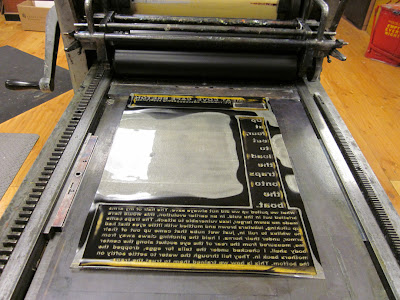


 A little bit into the runs the plates actually cracked. (The curling is a result of the plates slowly hardening and drying out, meaning that they are also becoming more brittle.)
A little bit into the runs the plates actually cracked. (The curling is a result of the plates slowly hardening and drying out, meaning that they are also becoming more brittle.) That reminded me of Robert Rauschenberg’s lithograph from 1963, Accident, where the stone broke during printing, but was used anyway and incorporated into the print.
That reminded me of Robert Rauschenberg’s lithograph from 1963, Accident, where the stone broke during printing, but was used anyway and incorporated into the print.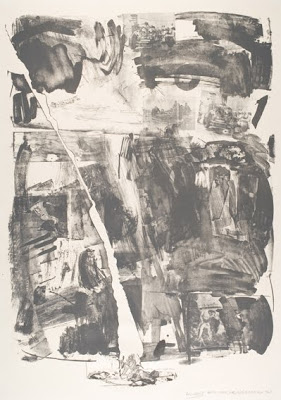 When I went back to printing What You Will about a month ago, I was concerned because even though I had stored the plates properly (flat, in plastic bags and in the dark) they had still curled quite a bit. And I had imagined them being as printed as dark, flat, perfectly geometric solids. I didn’t know what would happen. I was worried that the surface of the plates had warped and the type would be completely illegible. And I wondered, not so much worried, if the plates would crack. And I think that if they had, and assuming that the cracking would not have rendered the small type completely illegible, I would have went with it. Partly because I couldn’t afford to remake those plates for a third time, and also because the cracks would have added another layer of legibility. A nice, dark, as-planned solid lends a physicality to the print (especially in a book where the ink can be touched by the reader) but I think that they remain (at least somewhat) abstract. Whereas a cracked plate + print would be more concrete, more specific, more opaque, more legible, more present. The reader would be brought ever so slightly closer to the matrix and to the process.So maybe, maybe next time I will figure out how to really destroy those plates.
When I went back to printing What You Will about a month ago, I was concerned because even though I had stored the plates properly (flat, in plastic bags and in the dark) they had still curled quite a bit. And I had imagined them being as printed as dark, flat, perfectly geometric solids. I didn’t know what would happen. I was worried that the surface of the plates had warped and the type would be completely illegible. And I wondered, not so much worried, if the plates would crack. And I think that if they had, and assuming that the cracking would not have rendered the small type completely illegible, I would have went with it. Partly because I couldn’t afford to remake those plates for a third time, and also because the cracks would have added another layer of legibility. A nice, dark, as-planned solid lends a physicality to the print (especially in a book where the ink can be touched by the reader) but I think that they remain (at least somewhat) abstract. Whereas a cracked plate + print would be more concrete, more specific, more opaque, more legible, more present. The reader would be brought ever so slightly closer to the matrix and to the process.So maybe, maybe next time I will figure out how to really destroy those plates.
 I linked to this in a post last week, but it’s so fantastic that I’d thought I should mention it specifically: The William Blake Archive. It’s a comprehensive digital archive where you can view and read multiple copies of Blake’s illuminated/printed books. Things like this are one reason why the Internet and other digital technology is good for books, and good for those of us who are interested in them.Along with the works themselves there are also some informative essays about Blake’s life and about the process that he used to make the books. Here’s a brief passage (related to some other threads that have been running through this blog) from the essay about his process, “Illuminated Printing,” by Joseph Viscomi:
I linked to this in a post last week, but it’s so fantastic that I’d thought I should mention it specifically: The William Blake Archive. It’s a comprehensive digital archive where you can view and read multiple copies of Blake’s illuminated/printed books. Things like this are one reason why the Internet and other digital technology is good for books, and good for those of us who are interested in them.Along with the works themselves there are also some informative essays about Blake’s life and about the process that he used to make the books. Here’s a brief passage (related to some other threads that have been running through this blog) from the essay about his process, “Illuminated Printing,” by Joseph Viscomi:Blake realized very early that his new medium's autographic nature made the poem the only prerequisite for executing plates, that rewriting texts was also an act of visual invention, and thus that the medium could be used for production rather than reproduction. With no designs to transfer or reproduce, the placement and extent of text, letter size, line spacing, as well as placement and extent of illustration, were invented only during execution. This method of designing meant that Blake did not know what lines or stanza would go on what plate, or how many plates a poem/book would need. Working without models allowed each illuminated print and book to evolve through its production in ways impossible in conventional book-making. Blake could begin working on a book before it was completely written.
And of course you can also download Blake’s texts from Project Gutenberg.Several worlds to get lost in.
 This past Thursday (the seventh day of the seventh month) was the ILSSA (Impractical Labor in the Service of the Speculative Arts) Festival to Plead for Skills. Here is the description of the event from the ILSSA site:
This past Thursday (the seventh day of the seventh month) was the ILSSA (Impractical Labor in the Service of the Speculative Arts) Festival to Plead for Skills. Here is the description of the event from the ILSSA site:This summer, on the 7th day of the 7th month, ILSSA will celebrate its own version of The Festival to Plead for Skills. The festival is derived from the Chinese holiday of Qi Xi and the Japanese festival of Tanabata, in which celebrants wish for the betterment of their own craftsmanship. Instead of wishing, the ILSSA festival will be a holiday of practicing.
We hereby invite all ILSSA Members to observe this holiday by making small objects as iterations of their practice. The objects should be no larger than 2 inches in any dimension, and should be the natural result of practicing a skill: using a tool, trying a method, honing a technique. Conceive of this project as something you can complete entirely on July 7th. We imagine Impractical Laborers across the land, practicing together in observance of the holiday.
For this year’s festival (my first) I decided that I wanted to combine my practice with some hands-on research in type design. So I set up a series of 2” x 2” pieces of cover weight paper, each with a letter (laser)printed on it. I chose 5 different letters, in caps & lowercase, from three different typefaces (we were making 30 objects this year) that I wanted to study up close. The typefaces were: Palatino Linotype (my old favorite), Lucida Console (a weird san-serif face that I enjoy), and Matthew Carter’s Georgia (so that I could compare a serifed text face for the screen/web with one for print/book). After they were printed I delaminated each of them, carefully tracing their form. It was extremely satisfying to focus my attention on all the little details and to carry that attention through the actual cutting. This was probably some of the most accurate cutting I’ve done in a while. Something about focus, I suppose. This was a good and fun event, as it was personal and solitary (every participant chose what they wanted to do) as well as social (we all practiced together, and everybody gets one of each object). Every studio a networked node of production, independent and in concert.
This was a good and fun event, as it was personal and solitary (every participant chose what they wanted to do) as well as social (we all practiced together, and everybody gets one of each object). Every studio a networked node of production, independent and in concert.




 Printing on Kyle Schlesinger's What You Will has resumed, and has been going strong for the past two weeks. This post is sort of about that, but not really—It's about one of those weird, interesting things that can happen while one is working, those things that one needs to remember to use later. “Happy accidents” is what the kids like to call them. The pictures here show some strange, randomish printing on the tympan of the press. The “accidental matrix” here was a long piece of hair stuck between the quoin and furniture. It was long enough to pick up ink from the rollers and to brush against the tympan while I was printing. The line quality is really lovely, and of course the composition that is built up by the movement of the hair is something I never would or could have done if I had been trying to control it. This makes me wonder: what are the possibilities of a movable or flexible printing matrix, like pieces of hair, or string, or wire, or cloth, or something else?
Printing on Kyle Schlesinger's What You Will has resumed, and has been going strong for the past two weeks. This post is sort of about that, but not really—It's about one of those weird, interesting things that can happen while one is working, those things that one needs to remember to use later. “Happy accidents” is what the kids like to call them. The pictures here show some strange, randomish printing on the tympan of the press. The “accidental matrix” here was a long piece of hair stuck between the quoin and furniture. It was long enough to pick up ink from the rollers and to brush against the tympan while I was printing. The line quality is really lovely, and of course the composition that is built up by the movement of the hair is something I never would or could have done if I had been trying to control it. This makes me wonder: what are the possibilities of a movable or flexible printing matrix, like pieces of hair, or string, or wire, or cloth, or something else?
 The first (and hopefully not the last) Indie Lit City Summit will be held in Washington DC on July 16. What is it? Here's (part of) the description from the website:
The first (and hopefully not the last) Indie Lit City Summit will be held in Washington DC on July 16. What is it? Here's (part of) the description from the website:The Indie Lit City Summit is a regional gathering of editors, publishers, reading series coordinators, and other literary organizers to raise questions, surface issues, share information, and collaborate on solutions. There is an enormous amount of experience and expertise in our community that can be tapped into to better all our work.
I would definitely be going if I was still in the Baltimore/DC area. I would maybe even go now if I could afford it. The travel that is, because the event itself is FREE.And then there's the Independent Publishing Wiki, which I found through the City Lit Summit site. This kind of knowledge sharing & community building is wonderful.

I have been scouting around in the field of “book history,” and it is rich indeed. And of course the rest of the Internet: […] [L]iterary work by its very nature sets in motion many kinds of creative intentionalities. These orbit in the universe of the creative work—but not around some imaginary and absolute center. Rather, they turn through many different kinds of motion, at many structural scales, and in various formal relationships. The universe of poiesis no more has an absolute center than does the stellar universe we have revealed through our astronomy. What it has are many relative centers which are brought to our attention by our own acts of observation. The universe of literature is socially generated and does not exist in a steady state. Authors themselves do not have, as authors, singular identities; an author is a plural identity and more resembles what William James liked to call the human world at large, a multiverse.
Literary texts differ from informational texts by being polyvocal. Whereas “noise” is always a form of corruption for a channel of information, it can be exploited in literary texts for positive results. The thicker the description, so far as an artist is concerned, the better. (Minimalist styles of art thicken their media by processes of subtraction and absence.) A thickened text is a scene where metaphor and metonymy thrive (Coleridge’s “opposite or discordant qualities,” his “sameness with difference”). For [Hershel] Parker, the thickness comes from the artists’ imaginative resources, who can be counted on to put into their texts far more than they are even aware of. Parker’s “intention” includes, crucially, the vast resources of the unconscious and preconscious.
But thickness is also built through the textual presence and activities of many non-authorial agents. These agencies may be the artists’ contemporaries—these are the examples most often adduced—or they may not; furthermore, the agencies may hardly be imagined as “individuals” at all. The texts of Sappho, for example, gain much of their peculiar power from their fragmented condition […] [1]
[…] But what’s unique in the case of literature is that the text isn’t the finished work. A novel or short story isn’t a solid object. It’s just groundwork, and the reader’s imagination and reference points revive its content, extrapolate from its clues, and finish the work individually. In a way, when you’re writing a novel, for instance, you’re actually writing an unpredictable number of novels at once, and that number depends on how many copies end up being read. No other art form that I can think of involves that level of collaboration between artist and audience and disrupts the passiveness of being a work’s receiver with so much freedom and creativity. The high degree of interaction and codependence that the writer/reader axis makes possible is gorgeous and offers such a great opportunity to experiment with how text reacts when it comes in contact with the imagination. And writing allows you to play with the crapshoot decision of when a work is finished or, rather, when something is ready to be placed outside of your control and then finished by other people in largely unknowable ways. […] [2]
[…] But texts shape the response of readers, however active they may be. As Walter Ong has observed, the opening pages of The Canterbury Tales and A Farewell to Arms create a frame and cast the reader in a role, which he cannot avoid no matter what he thinks of pilgrimages and civil wars. In fact, typography as well as style and syntax determine the ways in which texts convey meanings. […] The history of reading will have to take account of the ways that texts constrain readers as well as the ways that readers take liberties with texts. The tension between those tendencies has existed wherever men confronted books, and it has produced some extraordinary results, as in Luther’s reading of the Psalms, Rousseau’s reading of Le Misanthrope, and Kierkegaard’s reading of the sacrifice of Isaac. […] [3]
[…] To this point I have been taking the word “text” to signify the linguistic text, the verbal outcome at every level (from the most elementary forms of single letters and punctuation marks up to the most complex rhetorical structures that comprise the particular linguistic event). And even if we agree, for practical purposes, to restrict the term “text” to this linguistic signification, we cannot fail to see that literary works typically secure their effects by other than purely linguistic means. Every literary work that descends to us operates through the deployment of a double helix of perceptual codes: the linguistic codes, on one hand, and the bibliographical codes on the other.
We recognize the latter simply by looking at a medieval literary manuscript—or at any of William Blake’s equivalent illuminated texts produced in (the teeth of) the age of mechanical reproduction. Or at Emily Dickinson’s manuscript books of poetry, or her letters. In each of these cases the physique of the “document” has been forced to play an aesthetic function, has been made part of the “literary work.” That is to say, in these kinds of literary works the distinction between physical medium and conceptual message breaks down completely. […] [4]
1. Jerome McGann, “The Socialization of Texts,” The Book History Reader, ed. David Finkelstein and Alistair McCleery (London: Routledge, 2002), 42.
2. From an interview with author Dennis Cooper that is part of the HTMLGiant “What is Experimental Literature” series of posts. You can read the whole interview (which is great) here.
3. Roger Darnton, “What is the History of Books?” The Book History Reader, ed. David Finkelstein and Alistair McCleery (London: Routledge, 2002), 21.
4. McGann, 43.
[First a quick note: This will be the last official post of “Manuscript Book Week,” but there will undoubtedly be more posts about manuscript books as research continues.] One interesting visual aspect of many of these manuscript books is the amount of spatial depth articulated on and in the pages, particularly on the pages that are heavily decorated/illuminated. The diagram below shows the relative depth of the different components of the spread pictured above, with the lightest shapes (white) showing the areas depicting the most depth, moving to black, where whatever is on the page seems to sit directly on or above the page surface.
One interesting visual aspect of many of these manuscript books is the amount of spatial depth articulated on and in the pages, particularly on the pages that are heavily decorated/illuminated. The diagram below shows the relative depth of the different components of the spread pictured above, with the lightest shapes (white) showing the areas depicting the most depth, moving to black, where whatever is on the page seems to sit directly on or above the page surface.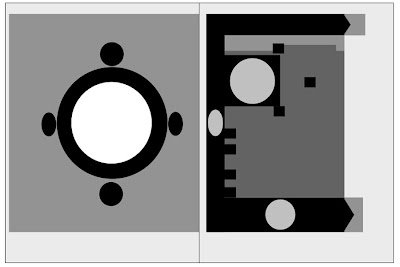 European manuscript books often mix “realistic” scenes that recede behind the picture plane, with abstract or trompe l'oeil decoration that stays on or above the picture plane. (For a quick comparison, scroll down to the post below and compare to the Qu’ran pages, with their more “modernist” use of geometric decoration.)The different colors of text and the actual surface of the page hover between those two poles, sometimes moving back and forth, depending on where the viewer/reader is looking. And of course the book itself is an object-in-space, on a table or in the reader’s hands, and participates actively in real space as well (as opposed to a painting, where the two-dimensionality seems fixed, because the painting is anchored to a wall).It would be interesting to use the kind of spatial manipulations demonstrated in manuscript books with photographic reproduction available now. If depicted three-dimensionality is actively used within a book, in concert with the (seemingly) two-dimensional pages moving in literal 3 & 4D space/time, plus the n-dimensional space of a properly tuned text, that could create a hyper-object that would tear a hole in the space/time continuum, as well as tear your face off and blow your mind up.
European manuscript books often mix “realistic” scenes that recede behind the picture plane, with abstract or trompe l'oeil decoration that stays on or above the picture plane. (For a quick comparison, scroll down to the post below and compare to the Qu’ran pages, with their more “modernist” use of geometric decoration.)The different colors of text and the actual surface of the page hover between those two poles, sometimes moving back and forth, depending on where the viewer/reader is looking. And of course the book itself is an object-in-space, on a table or in the reader’s hands, and participates actively in real space as well (as opposed to a painting, where the two-dimensionality seems fixed, because the painting is anchored to a wall).It would be interesting to use the kind of spatial manipulations demonstrated in manuscript books with photographic reproduction available now. If depicted three-dimensionality is actively used within a book, in concert with the (seemingly) two-dimensional pages moving in literal 3 & 4D space/time, plus the n-dimensional space of a properly tuned text, that could create a hyper-object that would tear a hole in the space/time continuum, as well as tear your face off and blow your mind up.


 Robert Ryman, Ledger, Enamelac paint on fiberglass, aluminum and wood, 1982.
Robert Ryman, Ledger, Enamelac paint on fiberglass, aluminum and wood, 1982. Robert Ryman, Series #33 (White), Oil on canvas, 2004.
Robert Ryman, Series #33 (White), Oil on canvas, 2004.






